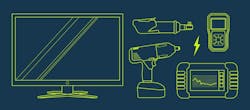The 2018 FenderBender Industrial Survey broke down trends that span the entire collision repair industry, all in an effort to find what’s driving the most profitable shops. The survey took a look at businesses from all angles, including KPIs, leadership qualities, training and education investments, pay plans—and, as detailed for this story, dedication to updating tools and technology in the shop.
Here’s a breakdown of what tools, equipment and technology trends are producing top-tier shops.
The Investment
Steve Trapp, North America services strategic accounts manager for Axalta, says no more than 10% of your annual revenue should be dedicated to technology and equipment spending. In the survey, 47% of respondents fell into that range:
What percentage of your business’s annual revenue do you allot for technology, tools and equipment investments?
0%: 1.3%
1–5%: 22.5%
6–10%: 26.8%
11–15%: 6.7%
16–20%: 6.0%
21% or more: 1.7%
I don't have a specific budget for technology, tools and equipment: 34.9%
Not having a budget is a huge no-no, but Trapp says spending too much on tools and equipment isn’t much better (“It’s not a sustainable business model,” he says). The tools and technology in your shop can only grow with the shop itself, and if you funnel too much cash into equipment, it takes away from other investments that grow your shop in other ways, such as education, marketing, facility expansion, employee growth, etc.
Here’s a breakdown of how a shop’s budget for tools and technology coincides with its profitability, according to the Industry Survey:
1–10% of Annual Revenue
Annual Revenue Above $2.5 Million: 48.5%
Overall Gross Profit Margin Above 40%: 67.3%
Overall Net Profit Margin Above 11%: 46.6%
Efficiency Above 140%: 54.8%
Productivity Above 110%: 51.6%
More than 10% of Annual Revenue
Annual Revenue Above $2.5 Million: 37.2%
Overall Gross Profit Margin Above 40%: 58.6%
Overall Net Profit Margin Above 11%: 37.5%
Efficiency Above 140%: 45%
Productivity Above 110%: 44.2%
No Annual Training Budget
Annual Revenue Above $2.5 Million: 38.5%
Overall Gross Profit Margin Above 40%: 56.5%
Overall Net Profit Margin Above 11%: 36.2%
Efficiency Above 140%: 44.6%
Productivity Above 110%: 46.7%
Scanning Stats
Of all the technology and tool investments you should make for your shop, Trapp says scan tools should be No. 1 on the priority list—multiple scan tools (or a third-party scan tool that handles multiple OEMs).
Jim Siegfried, co-owner of Crystal Lake Automotive, concurs, and notes the increasing need to own multiple scan tools that help technicians properly various brands.
The FenderBender Industry Survey asked various questions about scan tools, including how many scan tools a business owns:
How many OEM scan tools does your business own?
None: 29.2%
1: 36.2%
2: 21.1%
3: 6.4%
4: 1.0%
5 or more: 6.0%
Broken down by profitability metrics and various KPIs, here’s how each category fares when broken down to shops that have no scan tools, one scan tool, or two or more scan tools:
Owns No Scan Tools
Annual Revenue Above $2.5 Million: 26.7%
Cycle Time Below 7 Days: 72.1%
Touch Time Above 4 Hours: 30.1%
Average Repair Order Above $3,000: 47.9%
Overall Gross Profit Margin Above 40%: 57.8%
Overall Net Profit Margin Above 11%: 44%
Efficiency Above 140%: 34.1%
Productivity Above 110%: 30.8%
Owns One Scan Tool
Annual Revenue Above $2.5 Million: 34.3%
Cycle Time Below 7 Days: 77.6%
Touch Time Above 4 Hours: 33.9%
Average Repair Order Above $3,000: 43.6%
Overall Gross Profit Margin Above 40%: 57.5%
Overall Net Profit Margin Above 11%: 44.9%
Efficiency Above 140%: 45.2%
Productivity Above 110%: 29.3%
Owns More than Two Scan Tools
Annual Revenue Above $2.5 Million: 57.1%
Cycle Time Below 7 Days: 82.7%
Touch Time Above 4 Hours: 56%
Average Repair Order Above $3,000: 52.9%
Overall Gross Profit Margin Above 40%: 66.7%
Overall Net Profit Margin Above 11%: 53.9%
Efficiency Above 140%: 46.9%
Productivity Above 110%: 35.1%
The FenderBender Industry Survey also asked whether shops own third-party scan tools:
Does your business utilize a third-party service for scanning services?
No: 41%
Yes: 58%
Much like shops that own more OEM scan tools, there’s a noticeable difference in profitability between shops that do and do not own third-party scan tools:
Owns Third-Party Scan Tool
Annual Revenue Above $2.5 million: 42%
Cycle Time Below 7 Days: 76%
Touch Time Above 4 Hours: 47%
Average Repair Order Above $3,000: 52%
Overall Gross Profit Margin Above 40%: 64.5%
Overall Net Profit Margin Above 11%: 48.1%
Efficiency Above 140%: 47%
Productivity Above 110%: 42%
Doesn’t Own Third-Party Scan Tool
Annual Revenue Above $2.5 million: 37%
Cycle Time Below 7 Days: 77%
Touch Time Above 4 Hours: 54%
Average Repair Order Above $3,000: 44%
Overall Gross Profit Margin Above 40%: 61%
Overall Net Profit Margin Above 11%: 46%
Efficiency Above 140%: 40%
Productivity Above 110%: 37%
Mixed-Material Readiness
When forming your tech+tools budget, Steve Marks, industry technical support manager for I-CAR, notes the importance of tooling up and educating your staff on mixed-material vehicles. In the FenderBender Industry Survey, respondents were asked about their abilities to repair aluminum and advanced structural composites. While shops have largely readied themselves for aluminum, they haven’t made the same commitment to carbon fiber:
Does your business have the capability and equipment to repair aluminum components?
Yes: 63%
No: 20%
No, but plan to be aluminum-capable soon: 17.6%
Does your business have the capability and equipment to repair advanced structural composites or carbon fiber components?
Yes: 13%
No: 69%
No, but plan to be equipped for advanced composites soon: 18%
There are specific trends for shops that claimed to either be aluminum or carbon fiber ready in terms of what tools and equipment they invested in. Here’s a breakdown:
The Tools Aluminum-Ready Shops are Buying
92% have a 220v pulse MIG welder specifically for welding aluminum vehicles
33% have a designated welding fume-extraction system
69% have a specialized aluminum self-piercing rivet (SPR) gun
64% have a clean room that isolates aluminum repairs
44% have frame alignment fixtures
85% have a designated set of hand/special tools specifically for aluminum vehicles
37% a wet mix dust-extraction system
The Tools Advanced-Composite-Ready Shops are Buying
87% have a GMA MIG welder with silicon bronze welding capabilities
45% have dedicated specialty hand tools
53% have a clean room to isolate carbon fiber repairs
50% have a designated dust-extraction system
312% have a hot bonder unit
29% have vacuum bagging equipment
11% have an electronic digital tap hammer
29% have a heat blanket system
16% have caul plates for molding carbon fiber
13% have a freezer for prepreg carbon fiber reinforcement material

